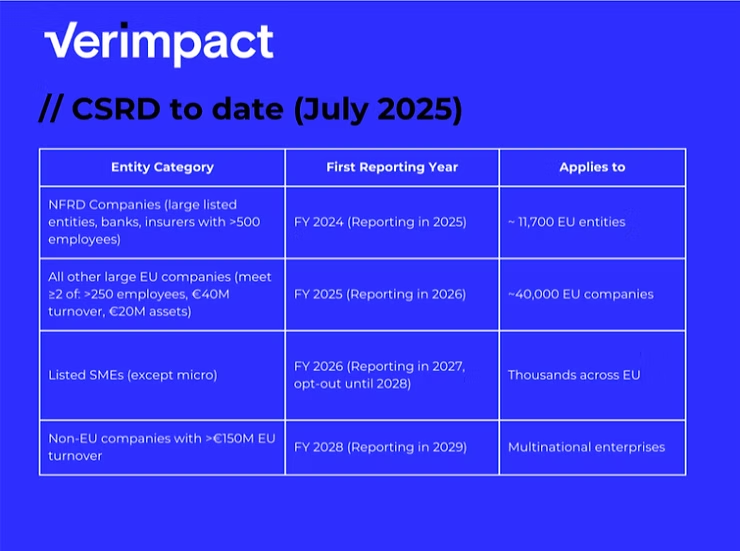Introduction
As we cross the midpoint of 2025, Sustainability and ESG compliance is shifting from a checklist to a performance-driven framework with the regulatory landscape changing dynamically across geographies, including in the European Union. New CSRD reporting timelines, evolving EU Taxonomy criteria, and rising investor scrutiny are pushing companies to reassess their ESG practices and build robust sustainability teams, making investments in the process mandatory. This policy brief for July by Verimpact outlines the updated CSRD timeline and sector expectations, the developments in the EU Taxonomy and a simple 3-step approach to recalibrate your strategy. Our team has envisioned this as a regulatory refresher for seasoned sustainability professionals and as primer for junior executives that are now starting their careers.
1. Updated CSRD Timeline & Expectations
The Corporate Sustainability Reporting Directive (CSRD) has been a transformative step in the EU’s approach to sustainability disclosures. Building upon and replacing the Non-Financial Reporting Directive (NFRD), it introduces mandatory double materiality, third-party assurance, and sector-agnostic standards via the European Sustainability Reporting Standards (ESRS). As there is a two-year delay in its implementation, introduced by the EU Omnibus simplification proposal, companies have been given additional time to prepare, without, however, reducing the complexity of the CSRD reporting.

Sources: European Commission, EFRAG, ESMA
July 2025 Update: Digital Tagging Delayed
The European Commission, in coordination with EFRAG and ESMA, was expected to finalize the XBRL-based digital taxonomy for ESRS-tagged disclosures by Q2 2025. However, this release has been delayed to Q4 2025, due to ongoing consultations on:
- Taxonomy alignment with the European Single Electronic Format (ESEF)
- Technical integration of machine-readable ESRS data for upload to the European Single Access Point (ESAP)
- Interoperability with national and global taxonomies
For companies preparing to report in 2026 (based on FY 2025), this delay means more time for testing internal data tagging infrastructure — however, there will be less room for last-minute adjustments.
Key Action: Strengthen Internal Alignment
The CSRD requires limited assurance of reported sustainability information starting from Year 1, with a gradual move toward reasonable assurance. Success hinges on tight coordination across internal teams. Leading organizations are already:
- Creating ESG reporting task forces linking finance, legal, sustainability, and IT
- Refreshing their double materiality assessments with 2025 climate and market risk data
- Conducting data readiness diagnostics to pre-validate KPIs, estimates, and assumptions
- Reviewing draft ESRS templates and sector-specific disclosures (as released by EFRAG)
By acting now, businesses can avoid late-stage reporting gaps and position themselves ahead of both compliance and stakeholder expectations.
2. EU Taxonomy Developments: From Climate to Circularity
What’s Currently in Effect (As of July 2025)
The first two environmental objectives — climate change mitigation and climate change adaptation — are fully in force since January 2022 for financial institutions under SFDR, and since January 2024 for companies reporting under CSRD¹. These cover sectors such as:
- Energy generation and transmission
- Construction and renovation of buildings
- Manufacturing of low-carbon technologies
- Low-emission transportation
The remaining four environmental objectives — water, circular economy, pollution, and biodiversity — are in draft or consultation phase and not yet required for full alignment reporting.
July 2025 Update: Sector Guidance Open for Consultation
In Q2–Q3 2025, the European Commission and Platform on Sustainable Finance launched public consultations for taxonomy criteria related to:
- Information & Communication Technology (ICT): including software, data centres, and cloud infrastructure (especially on circularity and energy use)
- Agri-food: farming, processing, packaging, and distribution (across water use, biodiversity, and pollution prevention)
- Manufacturing: particularly in textiles, chemicals, and electronics
These criteria aim to strengthen the EU’s alignment with the Green Deal Industrial Plan and support the shift toward sustainable industrial transformation. Final delegated acts are expected in early 2026, with implementation likely phased into CSRD disclosures for FY 2026–2027.

3. Verimpact’s 3-Step Recalibration Guide
As regulatory expectations around ESG reporting evolve, mid-year is a critical time for businesses to pause, reassess, and realign their sustainability strategies. Verimpact recommends the following three actions to help organizations shift from reactive compliance to proactive sustainability value creation:
1. Run a Double Materiality Refresh
Double materiality is no longer optional — it’s foundational under the CSRD and EU sustainability frameworks. Conducting a mid-year refresh allows companies to reassess both financial materiality (how sustainability issues impact business performance) and impact materiality (how operations affect people and the planet). Stakeholder expectations, climate risks, and supply chain vulnerabilities are shifting fast. A refreshed (or launching your first) double materiality analysis ensures your disclosures are grounded, credible, and responsive to current realities.
2. Map EU Taxonomy Exposure Across Business Units
With the EU Taxonomy extending beyond climate to cover circular economy, biodiversity, pollution, and water, organizations must go beyond basic eligibility screens. Now is the time to map how — and where — your activities align with the Taxonomy’s six objectives. Look beyond core business lines and assess subsidiaries, procurement flows, and even R&D. This mapping exercise will not only support disclosure obligations (e.g., for CSRD or SFDR) but also highlight opportunities to access sustainable finance or green procurement incentives.
3. Invest in Sustainability Data Infrastructure (Q3–Q4 2025)
Fragmented spreadsheets and manual tracking are no longer in fashion. From XBRL tagging requirements to real-time stakeholder reporting, robust sustainability data infrastructure is critical. Use the second half of 2025 to pilot or deploy tools that enable automation, auditability, and scenario modeling. Whether through AI-enabled platforms, centralized data lakes, or specialized software, these investments will prepare your organization for high-quality, decision-useful reporting in 2026 and beyond.
In Conclusion
As the regulatory landscape around ESG and sustainability continues to evolve, 2025 represents a pivotal year for businesses to shift from compliance-driven approaches to strategic sustainability leadership. By proactively addressing CSRD requirements, engaging with the expanding scope of the EU Taxonomy, and investing in robust data systems, organizations can future-proof their operations, enhance stakeholder trust, and unlock new sources of value.
Now is the time to move from preparation to implementation — and Verimpact is here to support that journey.
Contact us | Book a Discovery Call
Verimpact | Measure Impact, Drive Change
Verimpact is a sustainability intelligence and ESG strategy firm supporting companies, governments, and investors in navigating the transition to a more resilient, inclusive, and accountable future. With a presence in Athens, Abu Dhabi, and Limassol, Verimpact offers advisory services, AI-powered reporting tools, and executive training programs to help organizations align with evolving global standards such as CSRD, the EU Taxonomy, and SFDR, across geographies.
© Verimpact, July 2025
This material has been prepared for general informational purposes only and is not intended to be relied upon as accounting, tax, legal or other professional advice. Please refer to your advisors for specific advice.


